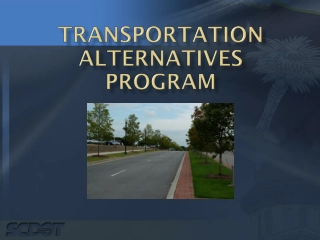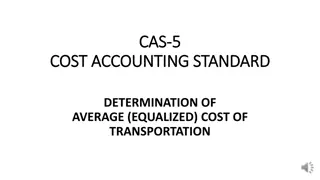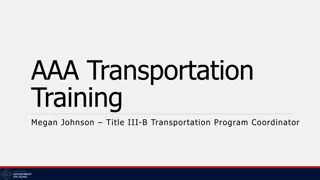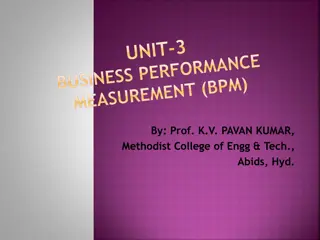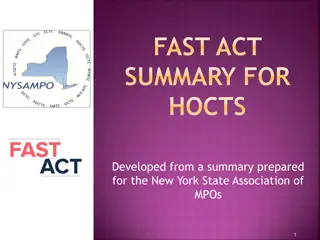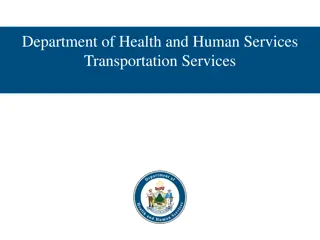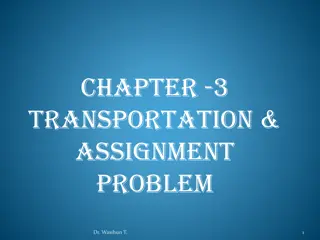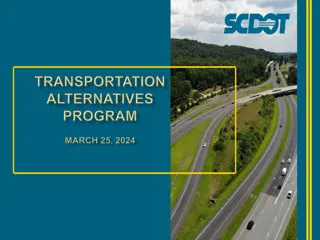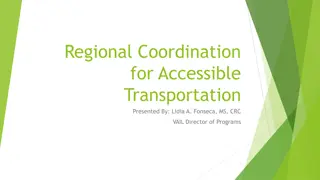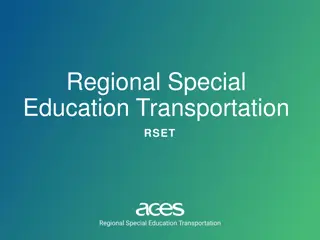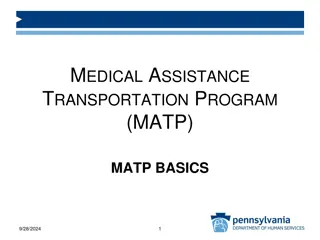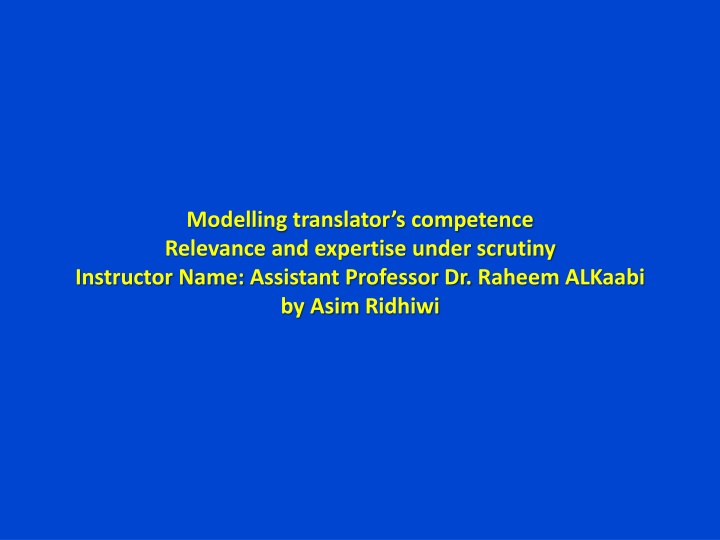
Transportation Performance Measures Research
This study, funded by the National Cooperative Highway Research Program (NCHRP), focuses on compiling current practices for developing planning performance measures in transportation. It delves into data integration methods, nontraditional performance measures, and research needs statements. The literature review findings highlight the importance of various data sources in assessing project effectiveness and addressing transportation needs, while also identifying data gaps and challenges within the field.
Download Presentation

Please find below an Image/Link to download the presentation.
The content on the website is provided AS IS for your information and personal use only. It may not be sold, licensed, or shared on other websites without obtaining consent from the author. If you encounter any issues during the download, it is possible that the publisher has removed the file from their server.
You are allowed to download the files provided on this website for personal or commercial use, subject to the condition that they are used lawfully. All files are the property of their respective owners.
The content on the website is provided AS IS for your information and personal use only. It may not be sold, licensed, or shared on other websites without obtaining consent from the author.
E N D
Presentation Transcript
Modelling translators competence Relevance and expertise under scrutiny Instructor Name: Assistant Professor Dr. Raheem ALKaabi by Asim Ridhiwi
Outline -Introduction -Assessing the plausibility of a dynamic cognitive model of translator`s competence based on relevance theory and connectionist principles. -In search of a model -Theoretical Underpinning -Assessing the Model - References
Introduction The dynamic cognitive model of translator s competence proposed by Gon alves (2003) differentiates between a specific and a general translator s competence, supports the amalgamation of procedural and declarative knowledge as constitutive instances of translation competence, and argues for an increment of awareness-raising, processes to develop this kind of competence. Translator s competence is, therefore, considered to be a particular cognitive configuration that allows translators to establish a balance between the periphery and the central layers of cognitive systems and, from a situated perspective, enables them to attain an inferentially resemblance between source and target text. meta-cognitive driven interpretive
Assessing the plausibility of a dynamic cognitive model of translator`s competence based on relevance theory and connectionist principles. -Translator s competence is considered to be a particular cognitive configuration that allows translators to establish a balance between the periphery and the central layers of cognitive systems and, from a situated perspective, enables them to attain an inferentially driven interpretive resemblance between source and target texts. Note: The central connectionist principle is that mental phenomena can be described by interconnected networks of simple and often uniform units. (https://en.wikipedia.org)
-Building on Andersons (1983) distinction between procedural and declarative knowledge, PACTE (2003) and Hurtado Albir (2005) define translation competence mainly as a type of procedural knowledge, that is, knowing how, rather than a type of declarative knowledge, that is, knowing that). what (or knowing -On the other hand, authors like Alves et al. (2000) and Sch ffner & Adab (2000) argue that awareness of the declarative knowledge involved in translation may help translators improve their performance. In short, they postulate that knowing what (or knowing that) is an important component of translator s competence and may therefore play a relevant role in the development of that competence.
Alves and Goncalves(2007) also consider that translation competence evolves gradually and postulate what they call narrow-band and broad- band translators that entail a set of cognitive behaviours that go from the mere transfer of linguistically encoded items to the point that a translator fully integrates a more complex body of sub-competences and is willing to take conscious responsibility for his/ her decisions.
-it can be assumed that there are different kinds and degrees of cognitive processes taking place alongside a translation task, some knowledge, some relying on declarative knowledge and some related to more or less conscious cognitive sub- systems. Incorporating these Gon alves (2003) proposed a cognitive model of translator s competence building on the principles of Relevance Theory. drawing on procedural different processes,
In Search of a Model Based on the above-mentioned frameworks, Gon alves (2003) carried out an exploratory study through which he located two domains of translator s competence expressed through the following theoretical principles: Translator s competence is a complex super-competence, which demands the coordination of various cognitive domains. There is a specific, core domain for translator s competence, which is guided by the Principle of Relevance (Sperber & Wilson, 1986/1995), in coordination competences, working mainly through conscious or meta- cognitive processes. with other sub-
- General translators competence is defined as , all knowledge, abilities, and strategies a successful translator masters and which lead to an adequate performance of translation tasks (Alves et al, 2000 :13). -For the explicitation of the second principle, i.e., a core domain for translator s competence called specific translator s competence, Gon alves (2003) drew on Relevance Theory concepts. Thus, this specific translator s competence (STC) is directly production of contextual effects generated from two counterpart translation units and to the overlapping of the two sets of effects, that is, the maximisation of their interpretive . proportional to the resemblance.
Theoretical Underpinning -According to Sperber and Wilson, human cognition develops by gradually and progressively adding and modifying mental representations in an individual s cognitive environment. Following this view, both cognition and memory are considered to be highly dynamic phenomena which generate the mental representations used by an individual in his/her processes of meaning construction. -Relevance Theory envisages two types of use for mental representations descriptive and interpretive. Each of these refers to a corresponding type of resemblance. -Descriptive resemblance establishes a correlation between an object or state of affairs in the world and a mental representation, while interpretive resemblance does this between two mental representations. Eg. The correlation between the word tree and the plant tree in the real world is that of descriptive resembelance. While the relation between tree and palm in terms of hyponymy is that of interpretive resemblance.
According to Relevance Theory, translation is a case of interpretive resemblance between two counterpart translation units ( TUs) situated, respectively, in a source and in a target language. correlation between the Arabic word and the English (university) is one of interpretive resemblance.
-Within the translators inferential context each TU is assumed to generate a number of contextual effects under the influence Relevance. Contextual effects are the result of inferential processing implemented by an individual along communicative interactions or information processing in which both new and given pieces of information are put together in order to improve his/her cognitive environment with the least necessary cognitive effort. of the Principle of
Within the Relevance Theory framework, we see translation as a progressive and recursive search for interpretive resemblance between two counterpart TUs. Translating, from a cognitive perspective, implies the progressive and recursive generation of contextual effects from two counterpart TUs and the search for an optimal overlapping between effects. these two sets of
From a connectionist perspective, the dynamics of the search for optimal interpretive resemblance, namely, the optimisation of a relation between cognitive effort and contextual effects, falls within the scope of the following tenets (Elman et al. 1996): cognition is seen not only as an internal mechanism developed by a genetic programme , but also as a result of external stimuli, what include social interactions experienced by the individual. Parallel processing is an important feature of cognitive systems a certain level of modularity (serial processing) is not the cause but a possible result of term recursive processes in cognitive development. Connectionist systems present a minimalist architecture they are basically made of processing units and connections, a system that is relatively analogous to the human nervous system . Connectionist networks are conceived of to enable certain learning abilities or a primitive kind of intelligent behaviour . Memory is conceived of as a plastic and dynamic device , an ongoing process, much more an effect of the very functioning of the network .
Building on Elman et al (1996), The sequence of figures below is a representation of stages of cognitive development represented in a sequence of figures which go from the early embryo, in a precognitive stage (2A), to the adult cognitive maturation of complex multi- purpose, Specific translator s competence (STC) based on Relevance Theory. highly interconnected systems (2G).
-Based on evidence found in Gonalves (2003), it is our assumption that the individual s profile will determine whether cognition will be situated more towards the periphery or more towards the centre of the system. Differences in the levels of expertise and of experience will account for the fact that some translators cognitive processes tend to gravitate more towards the periphery of the cognitive system remaining therefore under the influence of automatic processes.
Incorporating some of the sub-competences conceived of by PACTE (2003) bilingual,extralinguistic,instrumental knowledge-about-translation, competences coupled components we can combine Figure 1, which draws on Relevance Theory, with Figure 2, which builds on connectionist principles, and suggest the following model for translator s competence, integrating STC and some of the sub-competences postulated by PACTE (2003). namely, subcompetence, strategic psycho-physiological the and sub- with
STC is the core of a super-competence, which is expected to coordinate a set of different sub competences , operating conscious or meta-cognitive processes. mainly through
There are some auxiliary sub-competences that contribute to the improvement of STC. This auxiliary set consists of three sub-systems borrowed and adapted developed by PACTE (2003). It includes: 1- an instrumental sub-competence (INST ) that reflects the ability to use reference tools and to deal with several different external demands while carrying out a translation task. - from the model -
2- knowledge-about-translation ( KAT). It is mainly a declarative type of and is mostly learned explicitly and/or theoretically. knowledge 3-psycho-physiological subjective/emotional and physiological/motor aspects involved in translating and constitute an important interface between body regulation and subjective consciousness which, in translating, can be related to typing skills, postural and ERGONOMIC(1) behaviour, emotional balance and control under psychological stress, internal motivation etc. components (PP). These include both (1)Ergonomics understanding of interactions among humans and other elements of a system, and the profession that applies theory, principles, data and methods in order to optimize https://www.ergonomics.org.uk is the scientific discipline concerned with the human performance.
As for the model illustrated in Figure 3, the data analysis reveals that the performance of novice translators tended to gravitate more towards the periphery of their cognitive systems, signaling more automatic work, difficulties in processing contextually embedded information, and lack of meta-cognition to generate contextual effects.
Assessing the Model Durability is a cognitive pattern that can be observed in the translation process of expert translators. It can be mapped onto and assessed through the juxtaposition of features of expert performance, such as time spent on a task, degree of meta-cognitive monitoring(1) and reliable task output, particularly at the end of the drafting phase . As an extension of this concept, target texts can therefore be said to be more or less durable. (1)Metacognitive monitoring is a conscious consideration of one's cognitive abilities and an accurate assessment of cognitive resources. .From: International Encyclopedia of the Social & Behavioral Sciences, 2001.
s, Alves (2005b) compared the performance of two novice and two expert translators translating the same source text from English into Brazilian Portuguese and Iberian Spanish. The performance of the novice translators confirmed the findings of previous studies and illustrated a cognitive profile it has been decided to call a narrow-band translator. This narrow-band translator works mostly on the basis of insufficiently contextualised cues (for instance, dictionary-based meaning of words instead of contextualised meaning) and fails to bridge the gap between procedurally, conceptually and contextually encoded information.
the higher the levels of meta-cognition, the greater the balance between cognitive effort and contextual effects in translation. The expert translators : 1-Demonstrated an ability to coordinate the different demands of the translation tasks. 2- Seem to integrate the periphery with the central parts of their cognitive systems in an attempt to create a situated perspective for their cognitive functioning . 3- Contextually embedded information and meta-cognition drove their problem-solving and decision-making processes. 4- A striking feature observed in the retrospective verbalisations of expert translators is their reliance on themselves in passing judgment on their own decision-making processes. Whereas novice translators tend to be rather insecure when it comes to decision-making.
broadband translators tend to work mostly on the basis of communicative cues provided by the source text and reinforced by the contextual assumptions derived environments. This kind of cognitive behaviour enables them to integrate conceptually and contextually information into a coherent whole. from their cognitive procedurally, encoded
-In Figure 5 the components of the model are expanded to illustrate possible interfaces between the different layers of the system and the emergence of translator s competence from a meta-cognitive perspective. -An expert translator is able to move back and forth between the periphery and the centre of the system to decide at which level of contextual effects a given TU is to be processed. -One should bear in mind that translator s competence may prove more or less advanced according to different degrees of experience in particular knowledge domains.
References -Alves, Fabio and Gon alves, Jos L. 2003. A relevance theory approach to the investigation of inferential processes in translation . In Triangulating translation: perspectives in process oriented research [Benjamins Translation Library 45], F. Alves (ed.), 11 34. Amsterdam & Philadelphia: John Benjamins. -Alves, Fabio and Magalh es, C lia. 2004. Using small corpora to tap and map the process-product interface in translation . TradTerm 10: 179 211. -Elman, Jeffrey L., Bates, Elizabeth A., Johnson, Mark H., Karmiloff-Smith, Annette, Parisi, Domenico and Plunkett, Kim. 1996. Rethinking innateness: a connectionist perspective on development. Cambridge: MIT Press. -Gile, Daniel. 1995. Basic concepts and models for interpreter and translator training. Amsterdam & Philadelphia: John Benjamins. -Gon alves, Jos L. 2003. O desenvolvimento da compet ncia do tradutor: investigando o processo atrav s de um estudo explorat rio-experimental. [The development of translator s competence: investigating the process through an exploratory-experimental study]. Belo Horizonte: FALE/ UFMG (unpublished PhD thesis). -Gutt, Ernst-August. 2000. Translation and relevance: cognition and context. Manchester: St. Jerome.

